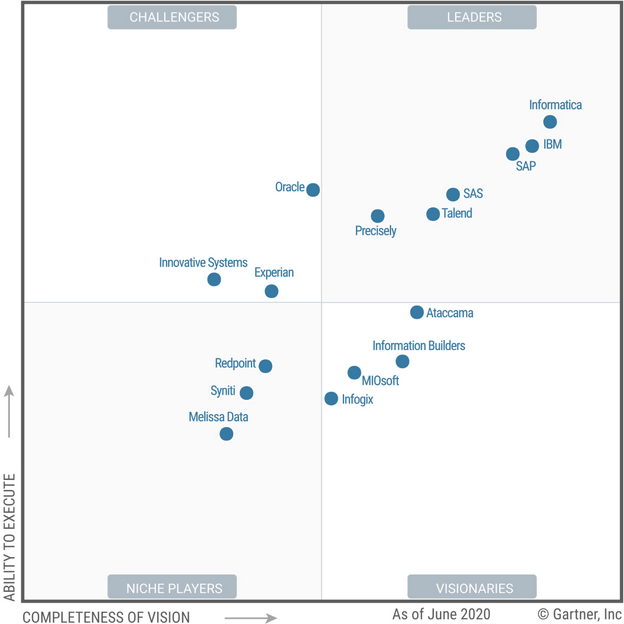Throughout the year, IT consulting firm Gartner releases their research and findings regarding a variety of market trends, in the form of Magic Quadrants. These reports highlight the top vendors in the field for different categories, along with their strengths and cautions, providing insights to key decision makers.
Just like others Magic Quadrants, the 2020 Gartner Magic Quadrant for Data Quality Solutions has been eagerly anticipated by organizations and clients alike, shedding light on top innovators in the field and what we can anticipate in terms of new solutions in the coming year.
New changes, new name
Given the fast innovation of technologies and expansion in market demands, Gartner changed the name of this Magic Quadrant this year from “Magic Quadrant for Data Quality Tools” to “Magic Quadrant for Data Quality Solutions.”
In previous years, this Magic Quadrant addressed the tools that typically offered effective data management capabilities, but Gartner acknowledged that efficient data quality practices require much more than just tools; companies rely on complete data quality solutions that support a variety of use-cases across different disciplines and industries. With this in mind, the research firm chose to reflect these changes in the vendors involved and criteria required.
Market definition of Data Quality Solutions
Gartner defines data quality solutions as “the processes and technologies for identifying, understanding and correcting flaws in data that support effective data and analytics governance across operational business processes and decision making.”
As the market for data quality solutions continues to expand and closely integrate with offerings such as metadata management solutions, data integration tools, and master data management, data quality solutions vendors are being expected to:
- Collaborate more with users and business leaders.
- Help operations run more efficiently.
Some solutions offered by these vendors include parsing, cleansing, profiling, standardization, enrichment, matching, and monitoring.
In order to qualify for inclusion in this quadrant, vendors must:
- Deliver core data quality functions such as matching, business rule creation, parsing, profiling, cleansing, or multidata domain support.
- Provide stand-alone on-premises software solutions that are sold specifically for data quality applications.
- Support multiple data domains across different industries.
- Maintain an installed base of more than 100 production customers for their products.
- Offer large-scale deployment via cloud-based and server-based runtime architectures.
Magic Quadrant for Data Quality Solutions 2020
The Magic Quadrant for Data Quality Solutions is represented here:

(Source)
Results at-a-glance
In order to fully utilize the results of the Data Quality Solutions Magic Quadrant, it’s necessary to understand each category:
- Leaders: Innovative giants who demonstrate depth across the full range of data quality solutions.
- Challengers: Companies that have an established presence along with robust product capabilities.
- Visionaries: Innovators who demonstrate a strong understanding of current and future trends in the market.
- Niche Players: Specialists who are often hyper-focused in a limited number of geographic areas or industries.
With these category definitions in mind, below are the results comparing last year’s Magic Quadrant to this year’s final results.
| 2020 Results | 2019 Results | |
| Leaders | Informatica IBM SAP SAS Talend Precisely | Informatica IBM SAP Talend Syncsort Oracle |
| Challengers | Oracle Experian Innovative Systems | Pitney Bowes Experian |
| Visionaries | Ataccama Information Builders MIOsoft Infogix | Information Builders Ataccama MIOsoft |
| Niche Players | Redpoint Syniti Melissa Data | RedPoint Global Innovative Systems BackOffice Associates |
Dominant Leaders
Although the three main vendors remained consistent in the Leaders Quadrant from 2019 to 2020, the rest of the category saw some new additions and dropouts.
Informatica
Informatica once again commands the top spot, rightfully placed there due to their four data quality solutions and deep understanding of the market. Both its multidomain support and data profiling features are consistently ranked as best-in-class, and their superior ease-of-use contributes to their continued Leader position.
Customers do report that installing their solutions is very technical, and their prices are steep compared to competitors. These are some areas to be looking for changes in the coming years.
IBM
With IBM’s Watson Knowledge Catalog being released in June, it brought to the industry some of the most forward-thinking machine learning and AI technologies of any other similar products on the market. IBM’s deep understanding of needs and demands continues to solidify its position as a Leader, with its data quality solutions modernizing the platform and integrating data governance, data quality, and data consumption into one experience.
A few cautions to keep in mind, though, are IBM’s plans to migrate its existing InfoSphere Information Server customers to the Watson Knowledge Catalog, as well as its more difficult product installation process.
SAP
Rounding out the top three vendors in the Leader category is SAP, who actually possesses the biggest market share of any data quality solutions vendor. With its innovative cross-tool integration strategy, SAP aims to provide tighter connectivity among its data management capabilities, including:
- Metadata governance
- Data integration
- Data preparation
The company does face some general challenges, with noted needs to improve its user interface for a better overall experience, along with continuing to improve their technical support.
Vendors added and dropped
Added:
- Infogix
- Melissa Data
- Precisely (formerly Syncsort)
- Syniti (formerly BackOffice Associates)
Dropped:
- Pitney Bowes (acquired by Syncsort in December 2019)
Data Quality Solutions in 2020
Although the main Leaders in the Data Quality Solutions Magic Quadrant remained the same again this year, the promises of innovative technologies and competitive pricings make this category something to keep an eye on. With more capabilities being added as data quality solution options, the landscape will only continue to change, bringing new ideas and growth.
Additional resources
Want to view more Magic Quadrants? Explore these resources:
- The 2020 Gartner Magic Quadrant for Data Center and Cloud Networking
- The 2020 Gartner Magic Quadrant for Application Security Testing
- The 2020 Gartner Magic Quadrant for Cloud Infrastructure and Platform Services
- Gartner® Magic Quadrant™ for ITSM
- The Gartner Magic Quadrant for SIEM
- The Gartner Magic Quadrant for Analytics and Business Intelligence Platforms







